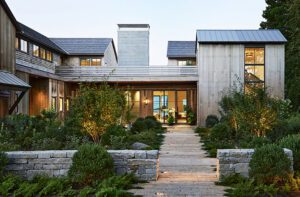Chatham Interiors Inc. Preserves Boston’s Architectural Charm, One Home at a Time
February 7, 2024
SPONSORED CONTENT
Text by Kaitlin Madden
If you stood in Copley Square and asked strangers about Boston’s appeal, there’s a good chance most of the answers would reference the city’s charm. Charm that Boston interior designer Melinda Headrick of Chatham Interiors, Inc. says largely stems from the area’s architecture.
Celebrating Boston’s Historic Architecture
“One thing I love about metropolitan cities is just the layers of history. I love walking the Boston streets and seeing the details on the outside of the houses. As I walk, I stop in awe sometimes over a rosette on the outside of the house or the detail on a pediment over a window or a fluted balustrade,” she explains. “There is so much ornamentation in Boston that is so lovely and that makes it the charming place that it is.”
Headrick, whose Cape Cod interior design business expanded to Boston’s SoWa design district last year, is doing her part to honor, and perpetuate, the area’s rich architectural history through her projects. While Headrick is an interior architect and designer by trade, she studied both design and sociology in school, where she became captivated by the way architecture captures the historic milieu.
Architecture Brings Historical Perspective
“I’m fascinated by society and how one trend evolves into another and how that affects all aspects like fashion or culture and art and design. Architecture is really a historical perspective,” she says. One that combines the materials that were available at the time with the area’s population and the cultural trends of the moment.
“In Boston, for example, you’ll see early American design but then as immigrants arrived, they brought new styles. You can see the whole story in the city’s architecture. You have Georgian and Greek Revival and Victorian and a little bit of art deco all in one area,” she says.
Balancing a Boston Home’s Architectural Style with the Homeowner’s Lifestyle
In her work as a designer, Headrick’s affinity for preserving history translates into spaces that honor the home’s original architect, as well as its current owner.
“I always pay homage to two things: a client, and what they need functionally and aesthetically from the home, and also to the home itself,” she explains.
Headrick’s approach is to study the architecture first, and then the client, because the former often provides clues about the latter. “If you live in an old home, there’s something about that that feels soulfully good for you as opposed to somebody who goes out and buys a really modern glass house with straight lines and one level,” she muses. She’ll often ask questions about a client’s early design memories, things they loved about the home they grew up in, or the homes of friends and relatives, and the things they didn’t.
Developing a Design Style
From there, she sets out to create rooms that tie together the client’s style with that of the home. “If [the style of the architecture and the style of the design] are blended well, it’s absolutely beautiful, and there’s a cohesive rhythm between the two. And whether you’re pulling in the driveway or sitting in a chair by the fireplace, you still have that beautiful, cohesive feeling all the way through. Home becomes a symphony.”
Of course, not every client lives in their dream home, architecturally speaking. Sometimes, a school district or location leads a client to choose a certain home regardless of aesthetics. Even then, Headrick says, there are solutions for creating homes that suit a client’s style without clashing with the bones of their house.
“Sometimes people say ‘I don’t like it, but I bought it because the school system was good and this was what was available,’ so then the conversation becomes, ‘We could put a gabled roof on it and it would change the whole perception,’ or whatever it may be,” she explains. “You can create certain elements of what you need in a way that feels natural.”
If a family lives in a traditional space but prefers a modern look, for example, her rule of thumb is to go seventy-five-twenty-five, in that seventy-five percent of the home is modern, while twenty-five percent is reflective of the home’s architecture. “You can throw down an antique rug in a room with very modern furniture and it’s explosive in the most beautiful way. Or there’s a way to bring midcentury modern in alongside an early American piece and a contemporary sofa with a track arm.”
Headrick discourages her clients from forcing an interior design that completely ignores the style of the home, and she encourages them to embrace the process of discovering things they will love and that foster architectural harmony.
“There’s so much joy in finding unique pieces that connect the dots to the outside of the home, the people who live there, and what they love,” Headrick concludes. “That’s like the perfect marriage in design.”
Chatham Interiors, Inc., Boston and Cape Cod, chathaminteriorsinc.com
Share
![NEH-Logo_Black[1] NEH-Logo_Black[1]](https://b2915716.smushcdn.com/2915716/wp-content/uploads/2022/08/NEH-Logo_Black1-300x162.jpg?lossy=1&strip=1&webp=1)















You must be logged in to post a comment.